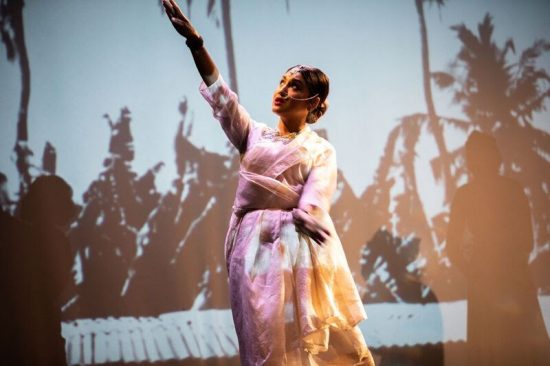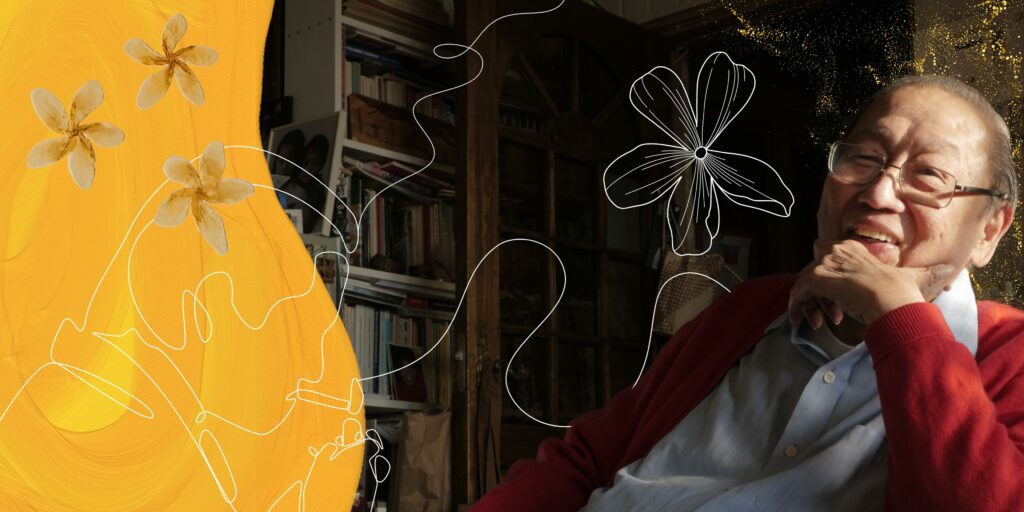I became a full-time community organizer in 1971. The Marcos government declared martial law in September 1972. A month later, the Marcos military came and arrested me.
September 20, 2022
The following essay is part of the Against Forgetting notebook, with art by Neil Doloricon.
The early ’70s were years of social foment. The year 1970 was the year of the First Quarter Storm, followed by the Diliman Commune at the University of the Philippines in 1971. While the First Quarter Storm was raging, I was in my first year at the local college as a political science and history major, after four years in the seminary made me realize that the priesthood wasn’t for me.
In the summer of that year, students and workers who were on summer break from schools and factories in Manila interacted with the likes of us curious students, who wanted to know what the situation was like in the capital. They talked of street battles with the police, with the MetroCom (Metropolitan Command of the Philippine Constabulary) up to the governmental seat of power in Malacañang, and the deaths of students, teachers, and workers.
I have always been a proponent of justice, even staging a small protest at the seminary when my classmates and I were made to eat cheap fried fish called “bading butete” right after we held a concert that made money for the seminary. As a curious student, I had to learn more about the reasons for this foment. I needed answers as to why tens of thousands, especially youth, were angry enough to fight the government in the streets. I joined discussion groups that expanded my perspectives on Philippine history and politics.
Our discussions reviewed the methodology and presentation of history by the writers of the textbooks we studied in school, like Gregorio Zaide and Teodoro Agoncillo, and the writings of Claro M. Recto, Jovito Salonga, and Jose Diokno.
I enjoyed the poetry of Amado V. Hernandez and Andres Bonifacio. I memorized José Rizal’s “Mi Ultimo Adios” and read the Noli Mi Tangere and El Filibusterismo. José Maria Sison’s Philippine Society and Revolution and the writings of V. I. Lenin, Ho Chi Minh, Mao Zedong, Lin Biao, and Deng Xiaoping were the more serious studies.
But more entertaining were the stories of the great bush generals Francisco Dagohoy, Gabriela and Diego Silang, the undefeated Moro and Cordillera peoples, and Antonio Luna. There were the tragicomic narratives of the Filipino Revolutionary Army’s race to the bottom of “who was the last general to surrender to the Americans.” And of course, Vo Nguyen Giap, the greatest bush general of Asia who led the Vietnamese to final victory against the French, Japanese, and the Americans.
Combining studies and struggle
I was enjoying those studies and discussions amidst a teachers’ strike for higher wages at my university, and student rallies against tuition fee hikes. The teachers on strike for higher wages talked with us about imperialism, feudalism, and bureaucrat capitalism as the three basic evils of Philippine society. Restless about issues of academic freedom and high tuition fees, we also talked of the age-old problem of landlessness of the tillers of the soil.
To better understand feudalism, I joined a student investigating-organizing group that went to the nearby countryside to hear firsthand from the peasants about their conditions. I learned about the “tercio” relations where the peasants had to give two-thirds of their harvest to the landowners for the use of the land that belonged to the landlord. This practice more deeply indebted the peasant to the landowner, who was usually absent from the farm, enjoying the fruits of the peasants’ labor in the towns and cities. The readings about feudalism became a more concrete reality for me.
As early as 1971, the rise of fascism became more obvious. And despite resistance from the growing nationalist and democratic forces and their allies, which included national leaders Jose Diokno, Jovito Salonga, and Ninoy Aquino, the Marcos government suspended the writ of habeas corpus.
The suspension of the writ only triggered the youth, students, professionals, and peasants to more quickly organize. I became a full-time community organizer in 1971. The Marcos government declared martial law in September 1972. A month later, while a friend and I were enjoying delicacies at another friend’s panaderia, the Marcos military came and arrested us.
We were just two of those included in the mass arrests conducted nationwide after the declaration of martial law. We filled detention centers and military camps. We were classified as CTs, or Communist Terrorists—a designation that just meant anyone who opposed martial law. Even violators of curfew and jaywalkers were detained as CTs, arrested without warrants and court hearings. Only a few detainees were arraigned and charged for show. I was neither arraigned nor charged.
I was first detained at Reagan Barracks, the central military headquarters in Legazpi City. I experienced physical and psychological torture, including solitary confinement. Soon after, I was transferred to the Camp Vicente Lim Detention Center in Calamba, Laguna. In Calamba, I saw thousands of other citizens detained by the Marcos martial law government.
From Calamba, I was transferred to the maximum-security prison at the Philippine Constabulary central headquarters in Camp Crame in Quezon City. I met the central committee members of the old Partido Komunista ng Pilipinas (PKP), the precursor to the current Communist Party of the Philippines (CPP), and the former Chairman Jesus Lava and Casto Alejandrino. Over ping-pong sessions, I listened to these storied rebels tell me about their lives.
I listened to the stories of Kumander Tatang, one of the famous leaders of the World War II-era Hukbong Bayan Laban sa Hapon (People’s Army Against Japan) or Hukbalahap, and Navy Captain-turned-rebel Danilo Vizmanos, a graduate of the United States Naval Academy and a high-ranking officer of the Philippine Armed Forces.
Kumander Tatang and Captain Vizmanos were apparently on opposite sides of the Hukbalahap Rebellion during the time of President Ramon Magsaysay. The two regaled us with stories of how Captain Vizmanos commanded the shelling of Mt. Arayat and Mt. Samat. Kumander Tatang told of how the Huks could not sleep without hearing the sigh of the wasted shells that flew over their heads and kept missing them.
Release from detention
In 1974, there was mounting international pressure to release political prisoners due to reports of torture. I was released from Camp Crame just in time for classes at the University of the Philippines in Diliman, where I transferred to study journalism and mass communications. On my birthday in 1975, the notorious group of torturers led by then-Captain Rodolfo Aguinaldo arrested me again for allegedly trying to join the New People’s Army. Tortured at the Military Intelligence Service Group in Camp Crame, I was placed in solitary confinement until released for classes on cognizance of an uncle who was the teacher of the then-military chaplain whom he berated for presiding over the military’s inhumanity.
I rejoined the underground movement after this, going back to organizing farmers, students, youth, and the middle class against martial law. By 1979, the underground was strong enough to face fascism openly despite the unabated human rights abuses–killings, massacres, arrests, tortures, and detention. I made friends and even mobilized the warlords of our region. We fondly and humorously called their armed formations the Goons for the Restoration of Democracy (GORD) and the Gangsters for the Restoration of Democracy (GARD).
Then August 21, 1983 happened. Ninoy Aquino, a former senator and outspoken Marcos critic, returned from exile in the United States and was blatantly assassinated upon arrival at the airport.
The hardships, the deaths, the massacres, and the fun of the fight against the dictatorship started to pay off with almost-daily rallies all over the country. Formal, informal, underground, and open alliances sprouted like mushrooms against the dictatorship. These struggles culminated three years later at EDSA (Epifanio de los Santos Avenue, named after a labor leader-writer-intellectual) in Manila. Even the oligarchy broke with Marcos due to his electoral cheating. The head of the Department of National Defense, Juan Ponce Enrile, and Constabulary Chief Fidel Ramos broke with the dictator and hid behind the people. And the people, having had enough, faced off with the tanks of the fascists. As the people closed in on the walls of Malacañang, Marcos and his family fled with the help of the U.S. government to Hawaii, with their loot of “diamonds in diapers.”
One of the oligarchs I met before EDSA asked me to work for him under the new Aquino government but I declined, trying to opt for a more normal life (I had three children by then).
In 1986, the then-underground National Democratic Front bureau asked me to head a panel to lead efforts to establish a just and lasting peace with the new government. But it was a time of multiple coup attempts, and I was arrested again in 1988 by the military faction of the Aquino government who wanted to brand Cory Aquino as a communist.
At the Bago Bantay Detention Center of the Armed Forces of the Philippines’s Military Intelligence Group 5, a senator and lawyer-friends visited me, wanting to know what my torturers were asking. The military’s questions stemmed from their age-old and continuing argument that the “opposition is red and therefore communist, and oppositionists (even Cory Aquino and her government) must be killed or imprisoned.”
Edcel Lagman’s House Committee on Human Rights also asked me and other detainees to appear before their committee in an effort to stop the torture and interrogations by the military intelligence. I was released a few weeks after the birth of my fourth child. Realizing they really had nothing on me, my jailers released me and wished me luck.
The continuing plunder of our country and our continuing struggle
So, even while martial law formally went away when the Marcoses went into exile, fascism has not stopped.
In 1988, I was one of the ten thousand plaintiffs awarded a restitution judgment from the Marcos Estate by the District Court of Honolulu in Hawaii. This judgment triggered the passing of the Republic Act 10368 in the Philippines, which awarded more than seventy thousand victims of human rights violations with reparations from the Marcos loot confiscated by the Swiss government and returned to the Philippine government. The Swiss government repatriated that chunk of ill-gotten wealth on the condition that a third of the money be allotted for compensation to victims of human rights violations during martial law. At the time of this writing, the Marcos estate still owes each victim at least $200,000 from the Hawaii judgment.
Arrests, tortures, massacres, and intimidation of community organizers and oppositionists continue to this day in one form or another. Plunder of mind-boggling proportions continues. This year, the son of the dictator wormed his way back into power, using disinformation, historical distortion, and widespread vote-buying to cheat his way to the presidency.
I thought that ousting Marcos and then Joseph Estrada—both Philippine presidential record holders in the plunder of a country’s coffers—and then assisting in the imprisonment of Estrada’s cheating presidential successor, Gloria Arroyo, would be enough to reverse the plunder and murder of my people. But this still appears to be a dream.
I have no choice but to continue to organize and fight the rotting plunder-and-murder monster oppressing our country and people, whose heads, like the Hydra, regrow as soon as and even before we can cut one. But it becomes fun as one comes to understand the joy of the battles-to-the-death of our ancestors Dagohoy, Diego and Gabriela, Andres and Gregoria, Marcelo, Juan and Antonio, and Macario, our brothers, the Moro people in the South and the Cordillera peoples of the North, and yes, our own Remontados de Isarog.
I say, go tell the Hydra: we will cut off each head you regrow!!!



